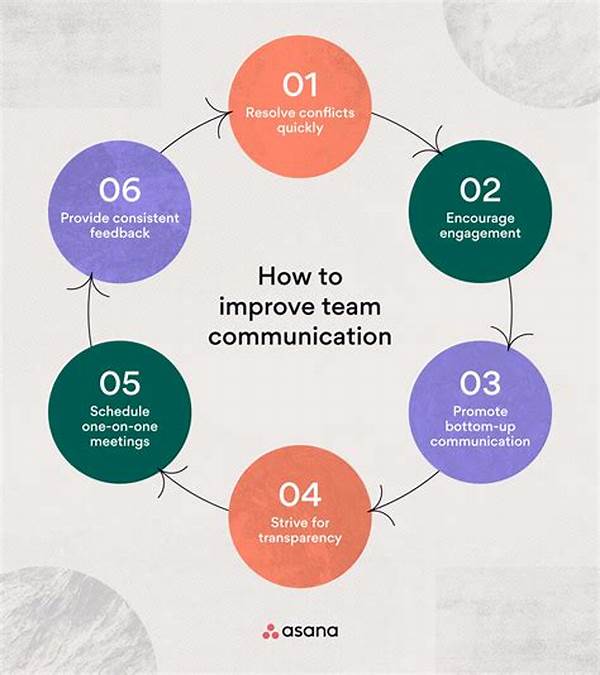In the bustling city of New York, where the rhythm of life beats to the tempo of endless Broadway productions, a new theater company was born. With members hailing from various backgrounds, from seasoned actors to fresh faces hungry for the spotlight, their challenge was not just to perform but to communicate like a well-oiled machine. The key to their success, as they would soon discover, lay in crafting impeccable communication strategies for acting teams.
Read Now : Encouraging Open Sharing Spaces
The Backbone of Success
The heart of any successful ensemble is built on trust and connection. Early on, the group gathered in dim-lit rehearsal spaces, where under the guidance of their director, they explored communication strategies for acting teams. Through improv exercises that compelled them to delve into intense eye contact and wordless exchanges, they learned to read each other like a book. It wasn’t just about lines from a script; it was about understanding the unspoken language of body movements and subtle cues.
Stories began to form, not only on stage but off-stage as the actors drew from shared vulnerabilities. This synergy empowered them to communicate more effectively during performances, adjusting instinctively to every unpredictable moment. Slowly, the narrative of a fragmented company transformed into one of a cohesive unit. They realized that the sum was indeed greater than its parts, and for a theatrical company, communication strategies for acting teams became their secret weapon.
Stories of Transformation
The first breakthrough came when Marcus, a senior actor, shared his struggle with cue lines. By opening up about his challenges, the team felt encouraged to express their own fears. Thus, communication strategies for acting teams became a lifeline, strengthening their collaborative spirit.
One day, the director suggested an unconventional exercise: swapping roles. Consequently, the actors gained new perspectives on their characters by adapting to different viewpoints. This method not only expanded their acting range but also enhanced communication strategies for acting teams.
During a particularly challenging rehearsal, an unforeseen blackout pushed the actors out of their comfort zones. The absence of visual cues required heightened sensory connection. The event was serendipitous, revealing the power and necessity of non-verbal communication strategies for acting teams.
Another story unveiled when Sarah, the youngest in the troupe, unleashed raw emotion during a poignant monologue. Authenticity became contagious. As vulnerability spread like wildfire, communication strategies for acting teams enabled them to channel undiluted emotions into compelling performances.
In collaboration with a visiting director, a cross-cultural dialogue emerged. Differences in training and methods were bridged by an eagerness to learn. This openness enriched the group with communication strategies for acting teams transcending cultural divides.
Building Trust and Expression
Over time, the theater company adopted several approaches to nurture communication strategies for acting teams. Trust exercises often began rehearsals—simple yet profound gestures like falling backward into another’s arms forged bonds stronger than words. They communicated assurance, forging a foundation upon which performances were built.
Expression workshops encouraged actors to explore their limitlessness. Through abstract painting and rhythmic movement, they communicated emotions via unorthodox mediums. These sessions decrypted personal inhibitions, allowing artists to relate deeply with their characters and, more importantly, with one another. This artistic freedom laid another brick in the structure of communication strategies for acting teams, fortifying a collective identity while celebrating individual artistry.
Practical Implementations
Implementing these refined strategies proved effective in numerous productions. Here are ten key methods:
1. Emphasizing active listening among cast members.
2. Encouraging post-rehearsal reflections, fostering constructive feedback loops.
3. Inviting open dialogue to dissect characters’ motivations and relationships.
Read Now : Iconic Broadway Show Finales
4. Practicing mindfulness to enhance presence both on and off stage.
5. Conducting improvisational exercises to improve adaptability.
6. Facilitating shared storytelling, creating empathy within the group.
7. Organizing team social gatherings outside the theater environment.
8. Integrating technology by recording rehearsals for insightful playback.
9. Co-creating a shared vision board, aligning team aspirations.
10. Maintaining a journal for personal reflections which contributes to group discussions.
Creating a Cultural Fabric
Within the blossoming tapestry of their community, communication strategies for acting teams became the golden thread weaving their stories together. Conducting read-throughs took on new meaning—every word nurtured in discussion, every line crafted with collective breath, and every silence amplifying hidden narratives. Their differing backgrounds formed a vibrant mosaic, amplified on stage, embraced off stage. They understood that missteps weren’t failures but stepping stones that added rich texture to their journey.
Thus, when the spotlight hit the stage on opening night, it wasn’t just talent that mesmerized the audience. It was the authenticity of a tribe that mastered communication strategies for acting teams. The palpable energy pulled the audience into their world, unraveling stories that echoed universal truths about trust, collaboration, and the essence of being human. Theatre-goers left the auditorium inspired, knowing they’d witnessed a performance that extended well beyond the script—a testament to communication strategies that transform acting teams into families.
Crafting the Final Act
In the end, the narratives created by employing communication strategies for acting teams transcends the barriers of language and culture. The group had transformed, their collective voice resonating beyond the confines of the theater. Each curtain call solidified a bond, united in diversity yet shaped by shared purpose. Evolving from disparate storytellers into a symbiotic ensemble became their legacy.
With every new project, as new members arrived, they were absorbed into the unyielding structure—a structure not built on mere talent but on the strength of communication strategies for acting teams. It was more than mechanics; it was magic—something tangible yet imperceptible. A force that made their stories unforgettable, reminding audiences and actors alike that in the art of theater, as in life, connection is everything.
